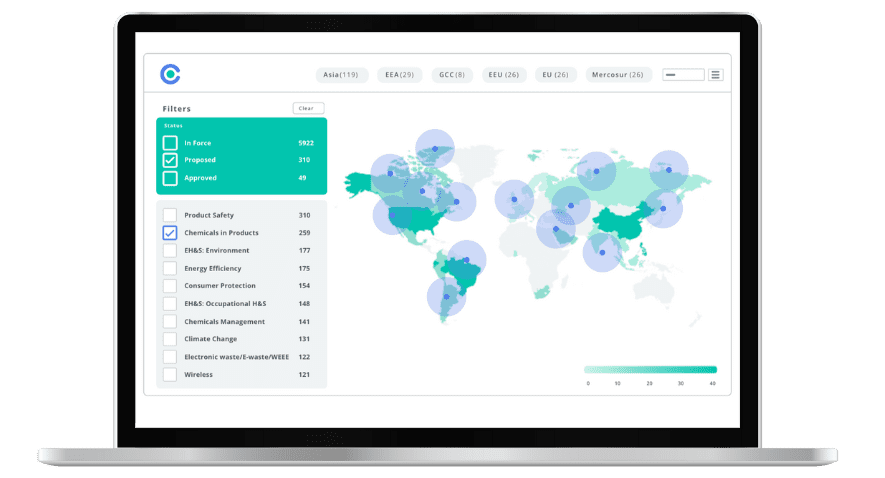
What You Need to Know About the Technical Regulations for Textiles in Saudi Arabia

This blog was originally posted on 4th March, 2024. Further regulatory developments may have occurred after publication. To keep up-to-date with the latest compliance news, sign up to our newsletter.
AUTHORED BY KIMBERLY PLASSCHE, SENIOR REGULATORY CONSULTANT, COMPLIANCE & RISKS
Introduction
The apparel and textiles industry are facing an increasingly regulated environment. Staying ahead of changing regulatory requirements presents growing challenges for businesses, with a 26% growth in textile regulations since 2020 alone.
In Saudi Arabia, the Technical Regulations for Textiles (Second Edition) was adopted on 12 January 2024. The Second Edition repeals and replaces the previous Technical Regulations. The Technical Regulations come into force 180 days following this publication in the Official Gazette.
In this blog, we give an overview of the Technical Regulations for Textiles in Saudi Arabia and the changes in the second edition.
Scope Changes
The scope of textile products subject to the new requirements was revised. A list of covered products and associated customs codes are included in Appendix 1-B.
Underwear, defined as a woven product that comes into direct contact with the skin, has been added to the scope of products covered by the Technical Regulations.
The Technical Regulations clarify exclusions to add certain medical products and footwear. The below product categories are not covered by the Technical Regulations:
- Products that are designed for medical purposes or medical claims, as they fall under the requirements and regulations of the Saudi Food and Drug Authority
- Footwear subject to the technical regulations for shoes and accessories
Labeling Requirements
A notable change to textile labeling requirements in the second edition is the removal of the requirement to label textiles in either Arabic or Arabic and English. The new language labeling requirement removes the reference to English, and now states the information must be in Arabic and may appear in another language in addition to Arabic.
Appendix Numbering
The numbering of the appendices in the new Technical Regulations has changed due to the deletion of three appendices. The below have been removed:
- Appendix 2, Tables of Value Limits for Chemicals Permitted in Textile Products
- Appendix 8, Azo Dyes – List of Aromatic Amines
- Appendix 9, Carcinogenic Dyes
Due to this change in the Appendices, references to appendix numbers have changed within the text.
Standard Specifications
The relevant standard specification listed in Appendix 1-A was updated. 65 standards have been deleted, and 13 added.
The newly added standards are:
- SASO ISO 6938, Textiles — Natural fibers — Generic names and definitions
- SASO GSO 2579, Children’s wear having reduced fire hazard
- SASO GSO ASTM D4522, Standard Performance Specification for Feather and Down Fillings for Textile Products
- SASO GSO 1833, Single-use-disposable baby diapers
- SASO 2865, Adult diapers for single use
- SASO 997, Sanitary pads for ladies
- SASO 403, Dimensions, geometrical details and usage of flags and banners of the Kingdom of Saudi Arabia
- SASO 402, The fabric of the national flag of the kingdom of Saudi Arabia
- SASO GSO 857, Woven Carpets
- SASO GSO 280, Car upholstery – Fabric for car seats
- EN 16781, Textile childcare articles – Safety requirements and test methods for children’s sleep bags for use in a cot
- EN 16779-1, Textile child care articles – Safety requirements and test methods for children’s cot duvets – Part 1: Duvet (excluding duvet covers)
- EN 16779-2, Textile child care articles – Safety requirements and test methods for children’s cot duvets – Part 2: Duvet covers (excluding duvet)
Taking Action
The Second Edition is completely revised from the previous Technical Regulations, and consultation of the full text to verify compliance with the new rules is recommended. As a member of the Gulf Cooperation Council (GCC), requirements set by its standards organization, Gulf Standardization Organization (GSO), should also be reviewed for applicability to apparel products sold in Saudi Arabia.
Stay Ahead Of Regulatory Changes
Accelerate your ability to achieve, maintain & expand market access for all products in global markets with C2P – Your key to unlocking market access, trusted by more than 300 of the world’s leading brands.
C2P is an enterprise SaaS platform providing everything you need in one place to achieve your business objectives by proving compliance in over 195 countries.
C2P is purpose-built to be tailored to your specific needs with comprehensive capabilities that enable enterprise-wide management of regulations, standards, requirements and evidence.
Add-on packages help accelerate market access through use-case-specific solutions, global regulatory content, a global team of subject matter experts and professional services.
- Accelerate time-to-market for products
- Reduce non-compliance risks that impact your ability to meet business goals and cause reputational damage
- Enable business continuity by digitizing your compliance process and building corporate memory
- Improve efficiency and enable your team to focus on business critical initiatives rather than manual tasks
- Save time with access to Compliance & Risks’ extensive Knowledge Partner network

Simplify Your Product Compliance Process with C2P
Design & build new products with full confidence you’ve met all compliance obligations


